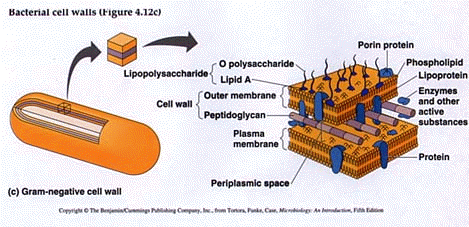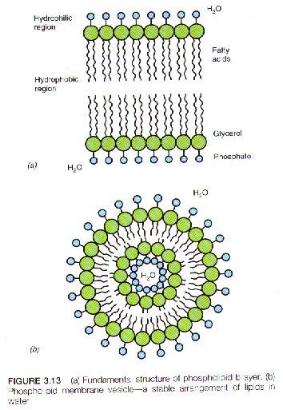CHAPTER 4.
Prokaryotic Organisms:
I. Typical Characteristics
-
Lack a nuclear membrane
-
Lack membrane-bounded organelles
-
DNA is not associated with histones
-
Cell walls made of peptidoglycan
-
Divide by binary fission
II. Size, Shape and Arrangements
-
Bacterial size is measured in microns (um). Variations in size occurs but
typically their size is 0.2 um in diameter and 8 um in length.
-
Three basic celll shapes: coccus, bacillus, and spiral
-
Cell arrangements are based on the patterns of division and whether the
cell remain attached afterwards:
-
Coccus:
-
diplococcus - pairs
-
streptococcus - cocci occur in long chains
-
staphylococci - irregular clusters
-
Bacilli:
-
diplobacillus, streptobacillus, coccobacillus
-
Bacilli divide only across their short axis.
-
Spiral:
-
vibrios - one twist, comma shape
-
spirillum (spirilla - plural) - corkscrew body very rigid
-
spirochetes - flexible bodies.
III. Structures external to the cell wall.
-
Glycocalyx / Capsule
/ Slime layer.
-
Usually made of polysaccharide, and sometimes protein. Protect cell from
animal defense mechanisms - avoid phagocytosis - very important with Streptococcuspneumoniae.
Help bacteria to adhere to surfaces (Strep. mutants) and tissues.
Source of nutrients. Protects against dehydration.
-
Flagellum:
-
Locomotion
-
Structural protein is flagellin
-
Three components: filament, hook and basal body
-
Useful in
taxonomy: mono (one), amphi (both), lopho (more than one in either
side) and peritrichous (over entire cell)
-
Many bacteria exhibit chemotaxis and phototaxis (can be positive or negative)
-
Axial filaments:
-
Present in spirochetes - often called endoflagellum
-
Pili/Fimbria:
-
Present in many Gram (-) cells - not involved in motility
-
Fimbria - are short and allow cell attachment to surfaces
-
Pili - long and used for conjugation (bacterial sex -bacterial DNA gets
transferred from one bacterial cell to another).
IV. Cell
wall:
-
Determines shape of cell
-
Protection from adverse conditions - Cell walls can be destroyed by antibiotics
and enzymes - penicillin, cephalosporin, lysozyme.
-
Made of Peptidoglycan - unique to Eubacteria
-
Structural support - prevents the cell from bursting
-
Site of action of some antibiotics
-
Made of two sugars: n-acetylglucosamine (NAG) and n-acetylmuramic acid
(NAM) and tetrapeptide amino acids.
-
See the figures below or see page 87 in Tortora's.
-
Bacteria can be divided into two large groups based on Gram stain:
Gram
positive - very thick cell walls. Layers and layers of peptidoglycan.
Also contains teichoic acid.

Gram
negative - very thin peptidoglycan layer in cell wall. Also has
an outer membrane
which is considered part of the cell wall. The
area between the outer membrane and the plasma membrane is called the periplasmic
space.
Outer membrane - In Gram negative (page 87).
-
Contains lipopolysaccharide (endotoxin)
-
Acts as a barrier to penicillin, lysozyme, and digestive enzymes

SEE TORTORA ET. AL. - Pg. 89 FOR A DESCRIPTION OF THE BIOCHEMICAL
DIFFERENCES BETWEEN G(+) AND G(-) BACTERIA.
-
Atypical cell walls
-
Acid fast bacteria - Have wax D
-
Mycobacterium tuberculosis
-
Mycobacterium leprae
-
No cell walls
Damage to cell wall: a)
lysozyme - disrupts the bond between the sugar---in Gram (+) this results
in protoplast and
in Gram (-) spheroplasts;
b) penicillin - disrupts peptide bonds.
IV. Structures Internal to the cell wall.
a) Plasma Membrane
Several names are used: cell membrane, plasma membrane or cytoplasmic
membrane.
- see pages 90 and 91.
-
Made up of phospholipids
-
DISCUSS STRUCTURE OF THESE MOLECULES WITH REGARD TO HYDROPHILIC
/ POLAR HEAD GROUPS AND HYDROPHOBIC HYDROCARBON CHAINS

-
Phospholipids are arranged in a bilayer in what is known as the
fluid
mosaic model.
-
Proteins are attached and inserted onto and into the phospholipid bilayer
-
Functions
-
Regulation of transport
-
Enzymes for respiration
-
Enzymes for energy generation
-
Receptors for recognition, communication, attachment
-
The cell membrane is a Selective permeable barrier
MOVEMENT ACROSS THE MEMBRANE:
a) Passive processes (no energy required)
-
Diffusion - movement of molecules from an area of high to an area
of low concentration - equilibrium.
-
Facilitated diffusion - requires a carrier protein present in the
membrane
-
Osmosis - the diffusion of water (solvent) across a semipermeable
membrane from high to low gradient concentration.
-
Since the membrane is not permeable to the dissolved solutes inside the
cell, water will move through the membrabe into the cell.
-
As this happens cell volume will increase, eventually surpassing the strength
and limits of the cell membrane and the cell will lyse.
Consequences of osmotic solutions:
1. Isotonic:
[SOLUTE inside cell] = [SOLUTE outside cell]
[WATER inside cell] = [WATER outside cell]
2. Hypotonic: Osmotic lysis (burst)
[SOLUTE inside cell] > [SOLUTE outside cell]
[WATER inside cell] < [WATER outside cell]
3. Hypertonic: Plasmolysis (shrink)
[SOLUTE inside cell] < [SOLUTE outside
cell]
[WATER inside cell] > [WATER outside cell]
b). Active transport
-
Requires energy - often ATP, a carrier protein and no gradient is necessary.
-
Two types: Active transport and Group translocation
-
Active transport: A carrier protein in the membrane binds the molecule
to be transported.
-
Group translocation. A combination effect during the passage of
a protein through the carrier allows the protein to be modified and once
inside the cell is unable to move out. (e.g. phosphorylation of glucose
to generate glucose-6P).
V. CYTOPLASM / CYTOSOL
-
Matrix inside the plasma membrane
-
80% WATER
-
Contains INCLUSIONS, RIBOSOMES, VACUOLES, NUCLEAR AREA.
a). Inclusions
Metachromatic granules - usually rich in phosphate
Polysaccharide (starch, glycogen)
Lipids
Sulfur
Gas
Magnetosomes
b). RIBOSOMES -
Particles made up of two subunits (30S and 50S)
Subunits are made up of RNA and PROTEIN
Proteins are made on ribosomes
Procaryotic ribosomes are small (70S) compared with eukaryotic (80S)
c). NUCLEOID
-
Lack nuclear membrane
-
Single chromosome, circular, double stranded DNA.
PLASMIDS
-
Small, circular double stranded pieces of DNA.
-
These are transferred very easily through conjugation.
-
The information on plasmids is often useful to the bacterium. It may even
be vital for survival under certain circunstances. But this information
is not considered to be part of the genome.
VII. ENDOSPORES - SEE PAGE 97
These are dormant (not metabolically active) bacterial cells.
Endospores are highly resistant to heat, drying and chemical disinfectants.
Bacillus sp. and Clostridium sp. are the most important spore
formers in medicine.
What is the difference between a vegetative cell and an endospore?


